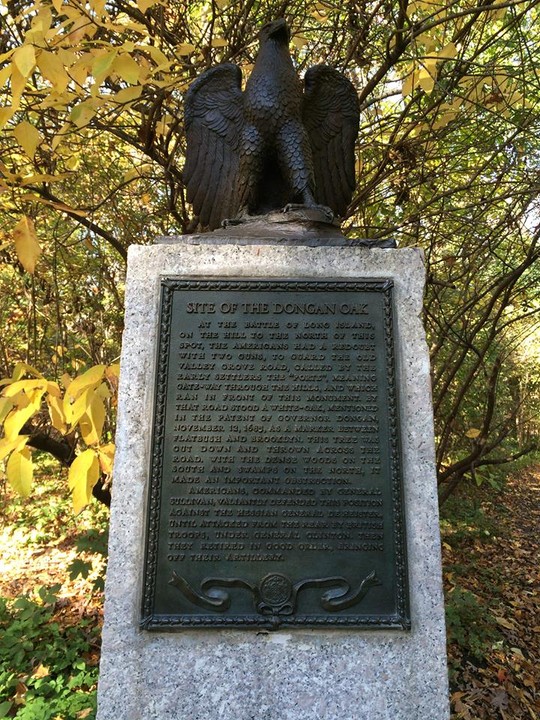Site of the Dongan Oak Monument
Introduction
Text-to-speech Audio
The Dongan Oak Monument marks the place where American troops chopped down an oak tree and used it to obstruct the road in Brooklyn, slowing down British advancement in the 1776 Battle of Long Island. This event saved countless American lives by giving them time to escape. The Monument was built in 1922 by Frederick W. Ruckstull, and it is made out of granite with a bronze eagle atop it and bronze plaque attached.
Images
The Site of the Dongan Oak Memorial

Backstory and Context
Text-to-speech Audio
The Battle of Long Island
After George Washington took Boston on March 17, 1776 at the Siege of Boston, the British fled the city. Washington guessed that they would try to take New York City, an important port, so he went to New York as fast as he could to set up defenses. In July, 32,000 British troops led by General William Howe landed on Staten Island. Washington split his troops, leaving some in Manhattan, and sending some to fortify Brooklyn. The Brooklyn troops set up defenses facing New York Harbor and Staten Island, as that was where the British attack was expected to come from. However, on August 27, the British crept up on the American Continental Army from the rear and the flanks via Jamaica. Surprised, the Americans weren't ready to stop the British from advancing onto them. To slow the British down, the Americans chopped down a large white oak tree, which fell across the road at this site, blocking the British advancement long enough to allow the Americans time to retreat back to Manhattan. George Washington was purportedly the last American to leave Brooklyn.The Monument
The plaque says (in original formatting):A plaque in the ground saysSITE OF THE DONGAN OAK
AT THE BATTLE OF LONG ISLAND,
ON THE HILL TO THE NORTH OF THIS
SPOT, THE AMERICANS HAD A REDOUBT
WITH TWO GUNS, TO GUARD THE OLD
VALLEY GROVE ROAD, CALLED BY THE
EARLY SETTLERS THE "PORTE", MEANING
GATE-WAY THROUGH THE HILLS, AND WHICH
RAN IN FRONT OF THIS MONUMENT. BY
THAT ROAD STOOD A WHITE-OAK, MENTIONED
IN THE PATENT OF GOVERNOR DONGAN,
NOVEMBER 12, 1685, AS A MARKER BETWEEN
FLATBUST AND BROOKLYN. THIS TREE WAS
CUT DOWN AND THROWN ACROSS THE
ROAD, WITH THE DENSE WOODS ON THE
SOUTH AND SWAMPS ON THE NORTH, IT
MADE AN IMPORTANT OBSTRUCTION.
AMERICANS, COMMANDED BY GENERAL
SULLIVAN, VALIANTLY DEFENDED THIS POSITION
AGAINST THE HESSIAN GENERAL DE HEISTER,
UNTIL ATTACKED FROM THE REAR BY BRITISH
TROOPS, UNDER GENERAL CLINTON, THEN
THEY RETIRED IN GOOD ORDER, BRINGING
OFF THEIR ARTILLERY.
The monument was cast and dedicated in 1922. It costed $2,000 ($27,145.89 in 2015 dollars). The stand is made of granite, and the eagle and plaque are made of bronze. The eagle was stolen in 1974, was replaced and rededicated in 1991, was stolen again, and was replaced a second time.THIS MONUMENT
DEDICATED ON
NOVEMBER 25, 1922
WAS RESTORED BY
THE PROSPECT PARK ALLIANCE.
ALEXANDER ETTL,
THE ORIGINAL CASTER
RECREATED F.W. RUCKSTULL'S
EAGLE AND PLAQUE.
REDEDICATED/JUNE 6, 1991.
Sources
"Dongan Oak Marker." NYC Parks. Accessed Web, 6/8/17. https://www.nycgovparks.org/parks/prospect-park/monuments/393.
"The Battle of Long Island." General Atomic. Accessed Web, 6/8/17. http://www.generalatomic.com/AmericanHistory/battle_of_long_island.html.
"Battle Pass." New York Freedom Trail. Accessed Web, 6/8/17. http://www.nyfreedom.com/BattlePass.htm.
Stockwell, Mary. "Battle of Long Island." Mount Vernon. Accessed Web, 6/8/17. http://www.mountvernon.org/digital-encyclopedia/article/battle-of-long-island/.
Stockwell, Mary. "Battle of Harlem Heights." Mount Vernon. Accessed Web, 6/8/17. http://www.mountvernon.org/digital-encyclopedia/article/battle-of-harlem-heights/.
Gabriel, Michael P. "Battle of Kip's Bay." Mount Vernon. Accessed Web, 6/8/17. http://www.mountvernon.org/digital-encyclopedia/article/battle-of-kips-bay/.
"The Battle of Long Island." General Atomic. Accessed Web, 6/8/17. http://www.generalatomic.com/AmericanHistory/battle_of_long_island.html.
"Battle Pass." New York Freedom Trail. Accessed Web, 6/8/17. http://www.nyfreedom.com/BattlePass.htm.
Stockwell, Mary. "Battle of Long Island." Mount Vernon. Accessed Web, 6/8/17. http://www.mountvernon.org/digital-encyclopedia/article/battle-of-long-island/.
Stockwell, Mary. "Battle of Harlem Heights." Mount Vernon. Accessed Web, 6/8/17. http://www.mountvernon.org/digital-encyclopedia/article/battle-of-harlem-heights/.
Gabriel, Michael P. "Battle of Kip's Bay." Mount Vernon. Accessed Web, 6/8/17. http://www.mountvernon.org/digital-encyclopedia/article/battle-of-kips-bay/.
